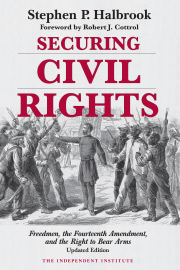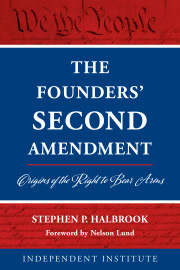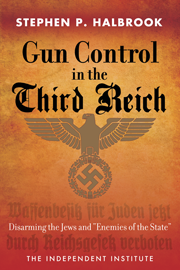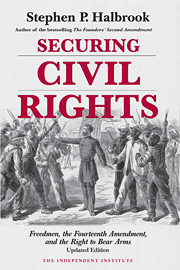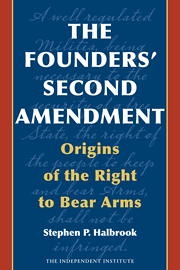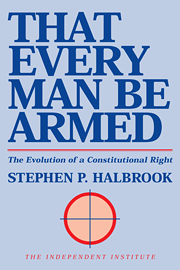Columbia Law Prof. Michael Dorf (Writ, Oct. 31) recalls the assertion by ex-Chief Justice Warren Burger that “the Second Amendment argument” is a “fraud on the American public.” Burger wrote that “the Constitution protects the right of hunters to own and keep sporting guns” and “the right to keep fishing rods” in that intellectual beacon Parade (Jan. 14, 1990). Burger railed against the NRA and “Saturday Night Specials,” but once pulled a pistol on someone who knocked at his door.
If any argument about the Second Amendment is a “fraud,” it is the assertion that the Framers intended the Second Amendment to protect a “collective” State right to maintain a militia, not an individual right to keep and bear arms. The 86-page opinion in United States v. Emerson, 2001 U.S. App. LEXIS 22386 (5th Cir. 2001), overflowing with quotations from the Framers, now forces Second Amendment deconstructionists to face the music.
The toughest music to face has always been the words: “the right of the people to keep and bear arms, shall not be infringed.” Only members of the legal profession could assert with a straight face that these words guarantee nothing to the people. That ordinary citizens consider themselves among “the people” mentioned in the Second Amendment demonstrates the observation by St. George Tucker, author of the first ever commentary on the Constitution (published in 1803), that the Bill of Rights was written so that the citizenry at large could understand it.
Emerson is the first ever federal appellate opinion to contribute an adequate textual analysis of the Second Amendment. It observes:
[T]he words “the people” have precisely the same meaning within the Second Amendment as without. And, as used throughout the Constitution, “the people” have “rights” and “powers,” but federal and state governments only have “powers” or “authority”, never “rights.” Moreover, the Constitution’s text likewise recognizes not only the difference between the “militia” and “the people” but also between the “militia” which has not been “call[ed] forth” and “the militia, when in actual service.”
That last clause, a neglected part of the Fifth Amendment’s indictment clause, tells tales. What Emerson calls the “sophisticated collective rights” view contends that the right to bear arms exists only when in actual militia service. When the Framers wanted to express that thought, they did so explicitly. Just as explicitly, the First, Second, and Fourth Amendments characterize peaceable assembly, keeping and bearing arms, and security from unreasonable searches as among “the right[s] of the people.”
Prof. Dorf ignores these textual fundamentals and submits his own inferential construct. The Second Amendment begins with the declaration, “A well regulated militia, being necessary to the security of a free state . . . .” This supposedly limits the substantive right to militia participation. But as Emerson explains, this preamble announces the objective of securing a free state by a militia, which in turn is encouraged by and drawn from the people who exercise the right to keep and bear arms.
Dorf finds another preamble in Article I, §8, “to promote the progress of science and useful arts, by securing for limited times to authors and inventors the exclusive right to their respective writings and discoveries.” The analogy is obscure, because Article I, §8 delegates a power to Congress. The Second Amendment delegates nothing to Congress, but bars it from infringing on the right described.
The draft of the bill of rights Madison proposed in 1789 included the declaration that a free press, “as one of the great bulwarks of liberty,” would be inviolable. He also proposed that in common law suits, “the trial by jury as one of the best securities to the rights of the people, ought to remain inviolate.” The existence of these preambles would not have authorized the government to abrogate the rights which were declared based on the assertion that the press is no longer a bulwark of liberty, or that jury trial is obsolete in securing the rights of the people. As Prof. Lawrence Tribe of Harvard University notes, “The people’s ‘right’ to be armed cannot be trumped by the [Second] Amendment’s preamble.” Nor can the government pronounce the militia dead and then decree that the right to bear arms is archaic.
Dorf asserts that “the phrase ‘bear arms’ was almost always used to refer to military service.” Yet he acknowledges the recognition in the Pennsylvania Declaration of Rights (1776) “that the people have a right to bear arms for the defence of themselves and the state.” This was the first state bill of rights to use the term “bear arms,” and Vermont adopted the same language. Jefferson drafted a bill which Madison proposed to the Virginia legislature in 1785 punishing a game-law violator if he should “bear a gun out of his inclosed ground, unless whilst performing military duty.” The minority report following the Pennsylvania convention of 1788 declared “that the people have a right to bear arms for the defense of themselves . . . or for the purpose of killing game.”
Noah Webster, a leading Federalist, defined “bear” as “to carry” or “to wear . . . as, to bear a sword, a badge, a name; to bear arms in a coat.” An American Dictionary of the English Language (1828). A civilian would bear arms in a coat by carrying a pocket pistol, but a soldier would bear pistols in holsters outside his coat.
The separate right to “keep” arms has no necessary military context. But Dorf denies Emerson’s conclusion that to keep means to possess: “‘keep and bear’ appears to have been understood as a unitary phrase, like other constitutional terms such as ‘cruel and unusual’ or ‘necessary and proper.’” Yet every one of these terms express different concepts. Keeping a gun at home is just not the same as carrying it abroad.
Dorf confidently reveals: “In my own research, I have not come across any documents of the Founding period that treat ‘keep’ as adding a right to private possession distinct from the military notion of arms-bearing.” Yet the basic Second Amendment literature and Emerson itself discuss Samuel Adams’ proposal in the Massachusetts convention of 1788 “that the said Constitution be never construed to authorize Congress . . . to prevent the people of the United States, who are peaceable citizens, from keeping their own arms.” This proposal was favorably remembered in newspaper commentary in 1789 when the Second Amendment was being debated in Congress.
Dorf takes issue with Emerson’s analysis of United States v. Miller, 307 U.S. 174 (1939). In Miller, a district court had declared as facially violative of the Second Amendment a requirement that short-barreled shotguns be registered. The U.S. Supreme Court reversed, observing that no evidence had been offered to show that such shotguns had a reasonable relation to a well-regulated militia. “[W]e cannot say that the Second Amendment guarantees the right to keep and bear such an instrument,” wrote the high court in Miller. “Certainly it is not within judicial notice that this weapon is any part of the ordinary military equipment or that its use could contribute to the common defense.”
The controversy in Miller was not whether the defendant was in the militia, but only whether his firearm could serve military purposes. Evidence on that issue would have been appropriate on remand.
Dorf describes the consequences of Emerson’s literal reading of Miller as “perverse” for giving constitutional protection to “distinctly military ‘arms’ such as tanks, attack helicopters, rocket launchers, or even nuclear missiles.” Yet individuals cannot “keep and bear” such crew-served weapons, which are thereby not protected by the Second Amendment. Ordinary rifles, shotguns, and handguns—such as the Beretta pistol in Emerson—are arms which can be kept and borne, and which have been traditionally kept for lawful purposes.
Lewis v. United States, 445 U.S. 55 (1980), noted that prohibitions on possession of firearms by a felon “are neither based upon constitutionally suspect criteria, nor do they trench upon any constitutionally protected liberties.” Emerson upheld a similar restriction on persons subject to restraining orders against domestic violence. Dorf argues that Emerson somehow contradicts Lewis, because “the statute at issue in Lewis applied to all firearms—not just ‘unmilitary’ ones like a sawed-off shotgun.” Yet this distinction is pointless because felons forfeit the right to possess any firearm.
Dorf suggests that historical changes are more significant than original intent. Professional police have replaced the citizen’s role in providing security, he claims. The Second Amendment may be “obsolete,” he suggests, even in high-crime areas where police are ineffective because being armed for self-defense may be more dangerous than being unarmed.
Yet a constitutional right cannot be repealed because the government declares it obsolete or dangerous. To suggest otherwise is to deny the rule of law.
And what happened on 9/11 precludes the serious consideration of any similar claim that the telephone number 911 abolishes the right of citizen defense, armed or unarmed. If ever there was a hue and cry, it took place on United Airlines Flight 93 in the skies over Pennsylvania. A “militia” consisting of a hunter who admired the Founding Fathers, a rugby player, a judo expert, and other citizens rushed the hijackers and paid the ultimate price to defend the lives of others.



